Honeybees hold a special place in many people’s hearts. A species which is ancient, intelligent and mysterious, bees can be seen as mediators between humans and the rest of the natural world. The symbiotic relationship between bees and beekeepers has been nurtured for thousands of years.
In many ancient cultures the bee was a symbol of power and nobility, a precious creature to care for hives in exchange for sweet, golden honey. Today, our love of the honeybee is undiminished and perhaps even intensified by the global threats that the species is facing of intensive farming, pesticides, disease and habitat loss.
Learn more about honeybees and our relationship with them in this guide by naturalist, artist and author Tiffany Francis-Baker:
What types of bee are in a honeybee hive?
A honeybee colony will consist of around 10,000 to 60,000 female worker bees, a few hundred male drones, a single queen, and lots of unborn larvae or ‘grubs’. These grubs have the ability to develop into workers, drones or another queen, depending on which cell they are born into and what they are fed.
Female workers live for five to six weeks in the summer, or five to six months if they live in the hive over winter. They are arguably the most useful members of the colony and carry out a variety of tasks, including foraging for pollen and nectar, tending to the queen and drones, feeding grubs, ventilating and defending the hive. Worker bees are female but are unable to lay fertilised eggs. However, if there is temporarily no queen, they are able to lay unfertilised eggs which become male drones.
Male drones are larger than a worker but smaller than a queen, although their eyes are twice the size of both. They perform only one role in the colony – to fertilise the eggs of new queens.
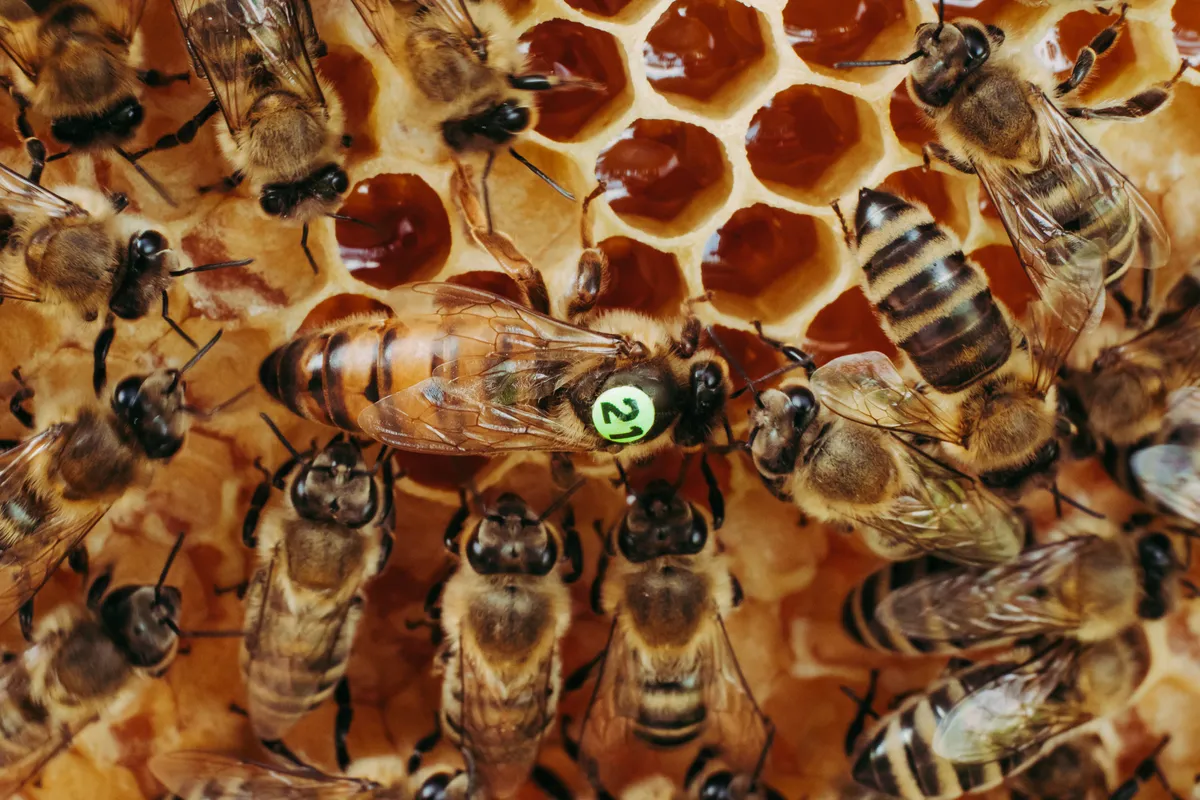
The queen honeybee is the most important member of the hive, giving birth to every other bee in the colony. She begins her life just like any other grub, but is nurtured to queen status by the worker bees who feed her a special diet of royal jelly, a protein-rich secretion from glands on their heads. After pupating, she chews herself out of her cell and proceeds to destroy any other queen bee pupae that may have emerged, as well as any lingering old queens that have not yet left the hive. Once the undisputed ruler of the colony, she leaves the hive to mate with a selection of drones (see below). She will then use this sperm to fertilise eggs for the next seven years, laying up to 2,000 eggs a day.
Do queens ever leave the hive?
Honeybee queens very rarely leave their hive, but one reason to do so is for mating.
Honeybee mating is seldom seen. Hundreds or even thousands of drones pursue a queen in a large, teardrop-shaped cloud known as the ‘drone comet’. Copulation usually takes place in mid-air. A male grabs the queen and inserts his endophallus (an inflatable part of his genitalia) into her. When he lets go, the flexion of his body against the rushing air compresses his abdomen, forcing release of sperm and sudden castration. Further mating may occur, with each male removing the previous suitor’s endophallus. When the queen returns to the hive, the last mate’s genitalia remain in her tail-tip – a sign to her keeper that she has mated.
This Q&A originally appeared in BBC Wildlife Magazine, and was answered by Richard Jones.
Do all honeybees sting? Why do they sting?
Located at the end of the abdomen, female honeybees have an adapted ovipositor (a structure originally used for laying eggs) which allows them to sting. Honeybees will sting other animals if they perceive a threat to themselves or the colony.
The stinger of the worker bee is barbed, which means that once it is used in an attack, it will usually be torn away as the bee struggles to free herself. This will result in the death of the bee. The queen has no barb on her stinger so can sting multiple times in theory, but it is rare to be stung by a queen bee. The male drone bees have no stinger at all.
Which is more painful between a honeybee and a wasp sting?
Bee and wasp venoms are highly toxic and social wasps (yellowjackets) possess chemical cocktails. A dose of only 15 microlitres (about 1/65,000 of a gram) causes intense pain, swelling, redness and local tissue damage. You’ll need a sit down with a cup of tea after 10 stings, and should seek urgent medical attention with 100. There’s no antivenom, but immediate dialysis can remove the toxins before serious damage to internal organs. Most adult humans would be lucky to survive 1,000 stings.
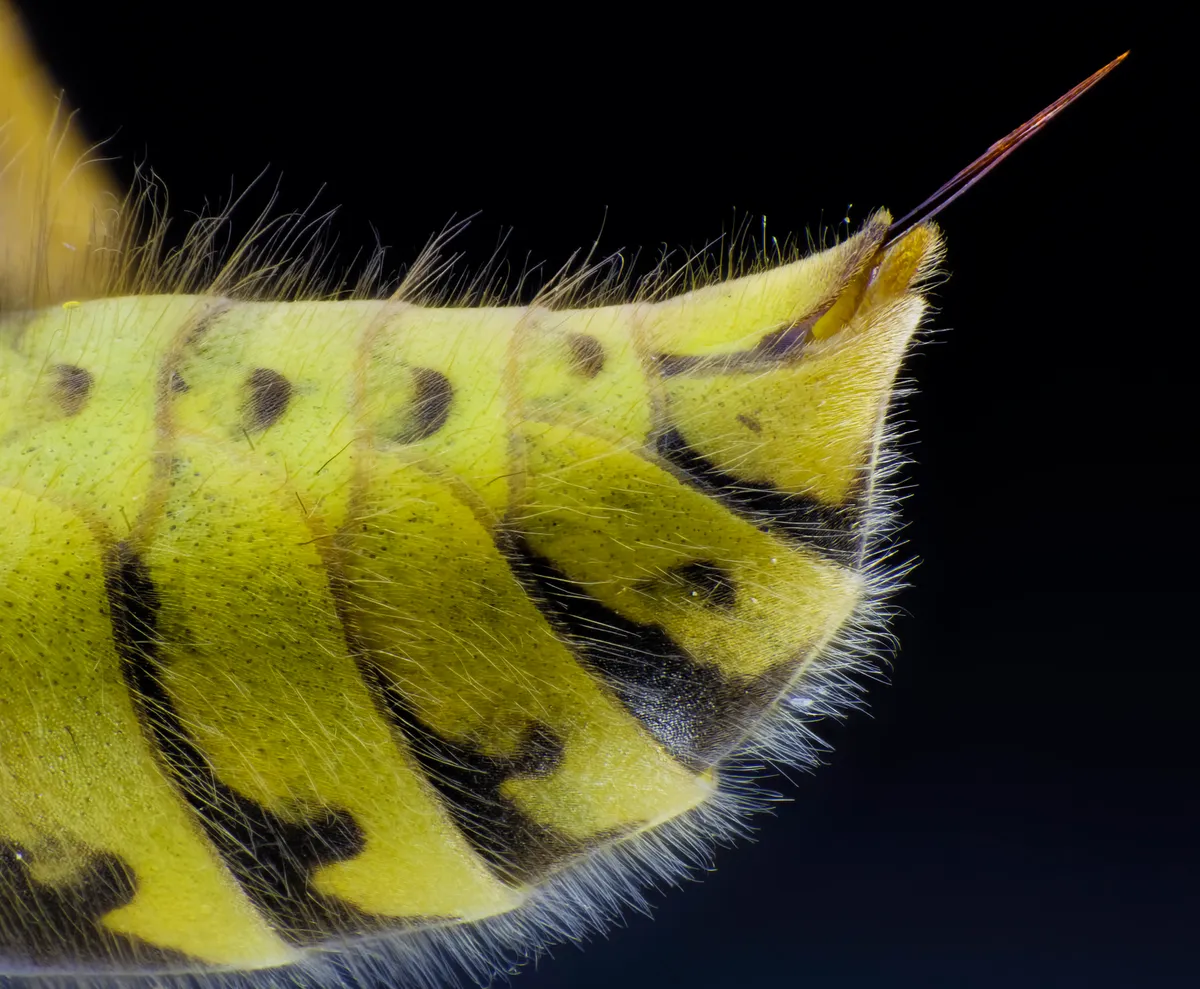
Europe’s honeybees stings of similar potency, but the barbed stinger keeps it lodged in your skin, along with the pumping venom sac. Even if the bee is brushed away, the pain continues. The bee also releases an airborne alarm scent, tagging you as the enemy, which recruits others from the hive into a potentially dangerous escalating attack. Honeybee stings are the ones to be wary of.
This Q&A originally appeared in BBC Wildlife Magazine, and was answered by Richard Jones.
Can honeybees count?
New research at the University of Sheffield has taken a method used to test numerical cognition in bees and other animals a step further, effectively using bees to put the test to the test. Honeybees were trained using a sucrose reward to choose feeding stations based on whether they were marked with the most spots, or the fewest. Once trained, the bees were consistent so, according to the test, it appeared they were counting the spots.
However, when the same bees were given stations marked with different shapes, things changed. The bees trained to choose the highest number of spots flew to stations with fewer shapes, when those shapes had a higher number of other variables, such as longer edges or curves. This demonstrated their decision was not necessarily numerical, something that would have been easily overlooked, had the test not been tested.
This Q&A originally appeared in BBC Wildlife Magazine, and was answered by Ellen Husain.
How do honeybees make honey? What else do honeybees produce?
Honeybees are most well-known for making honey, but they also produce a variety of other substances which humans have found a range of uses for, including beeswax, honeycomb, bee pollen, propolis, and royal jelly.
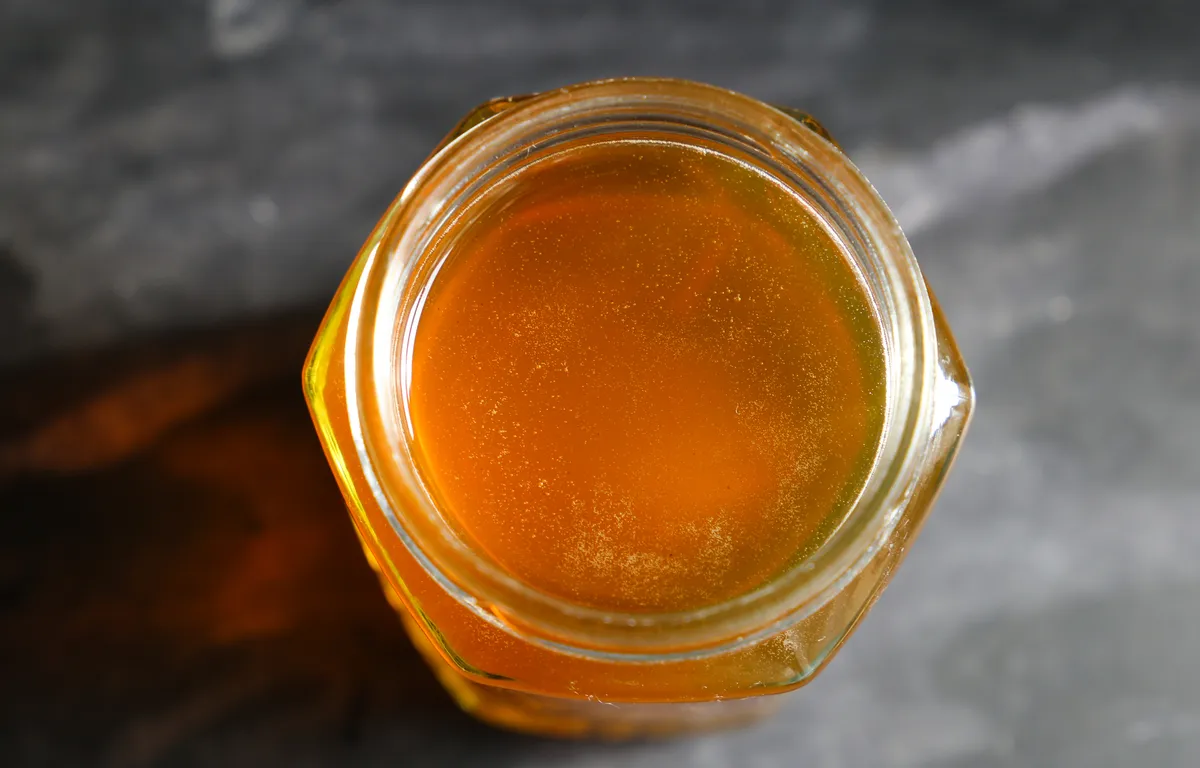
Honey is a sweet, gloopy, golden substance made using sucrose from the nectar collected by bees. The bees combine this sucrose with their own secreted enzyme called invertase, then concentrate it by packing it into a honeycomb to allow excess moisture to evaporate. Honey is traditionally believed to have antiseptic and anti-inflammatory properties which have seen it used as a medicine for thousands of years. Other historical uses have included treating wounds, easing symptoms of a cold and even embalming dead bodies. At home, it’s best spread on warm toast or mixed with fresh ginger and hot water for a comforting winter drink.
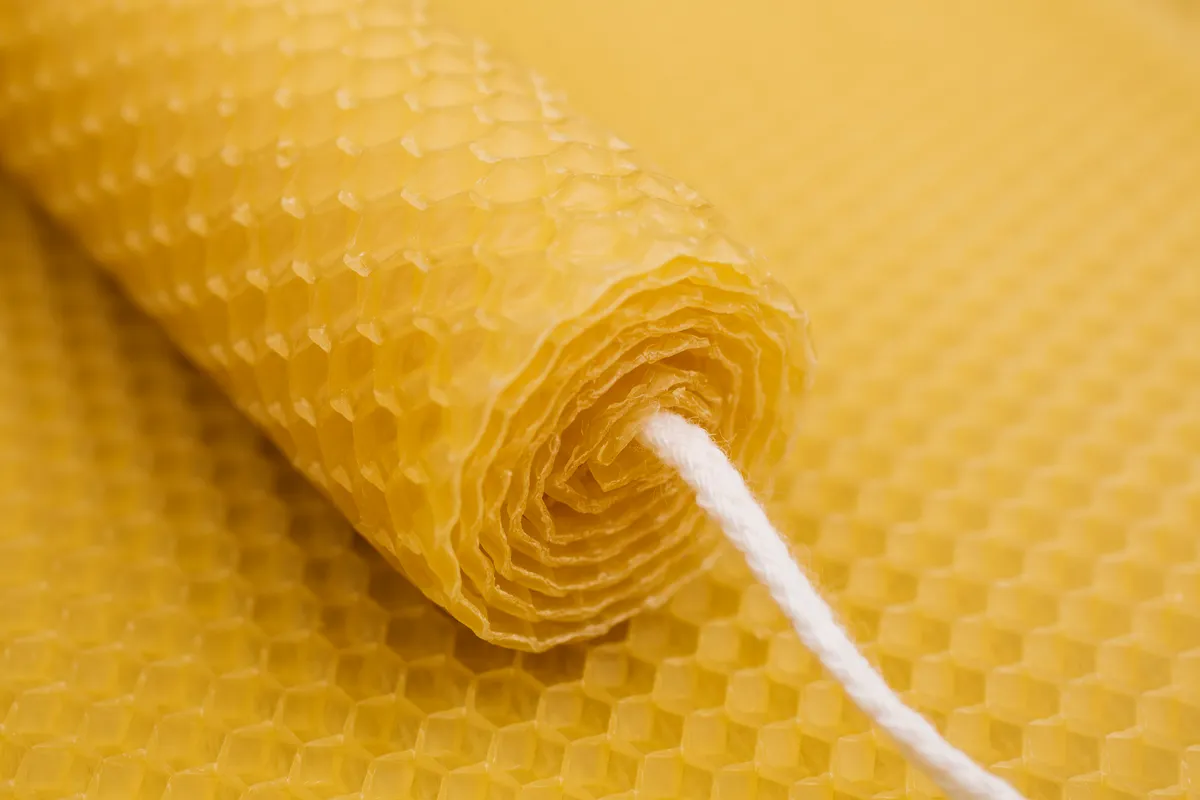
Beeswax is secreted by worker bees from glands on the underside of their abdomens. In its natural form, beeswax is actually white. Beeswax has been used for thousands of years as a lubricant and waterproofing agent, and can be used to make candles. Beeswax wraps make a great alternative to plastic wrap.
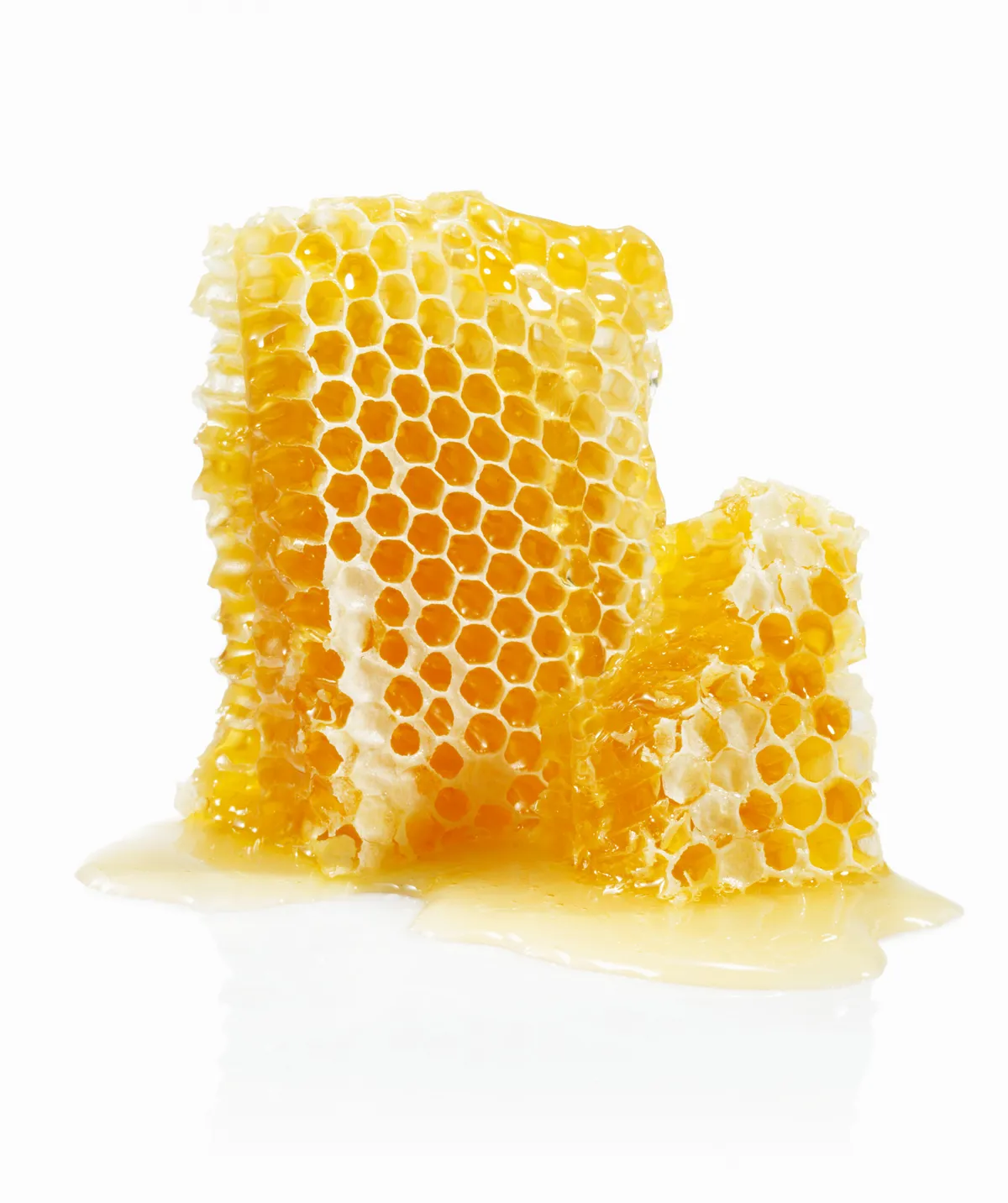
Honeycomb is the mass of hexagonal prismatic wax cells that honeybees build in their nests to store their larvae, honey and pollen. Today, beekeepers are able to remove the entire comb and extract the honey without damaging it. Honeycomb is safe to eat.
Please note that external videos may contain ads:
Why do bees build hexagonal honeycombs? © BBC
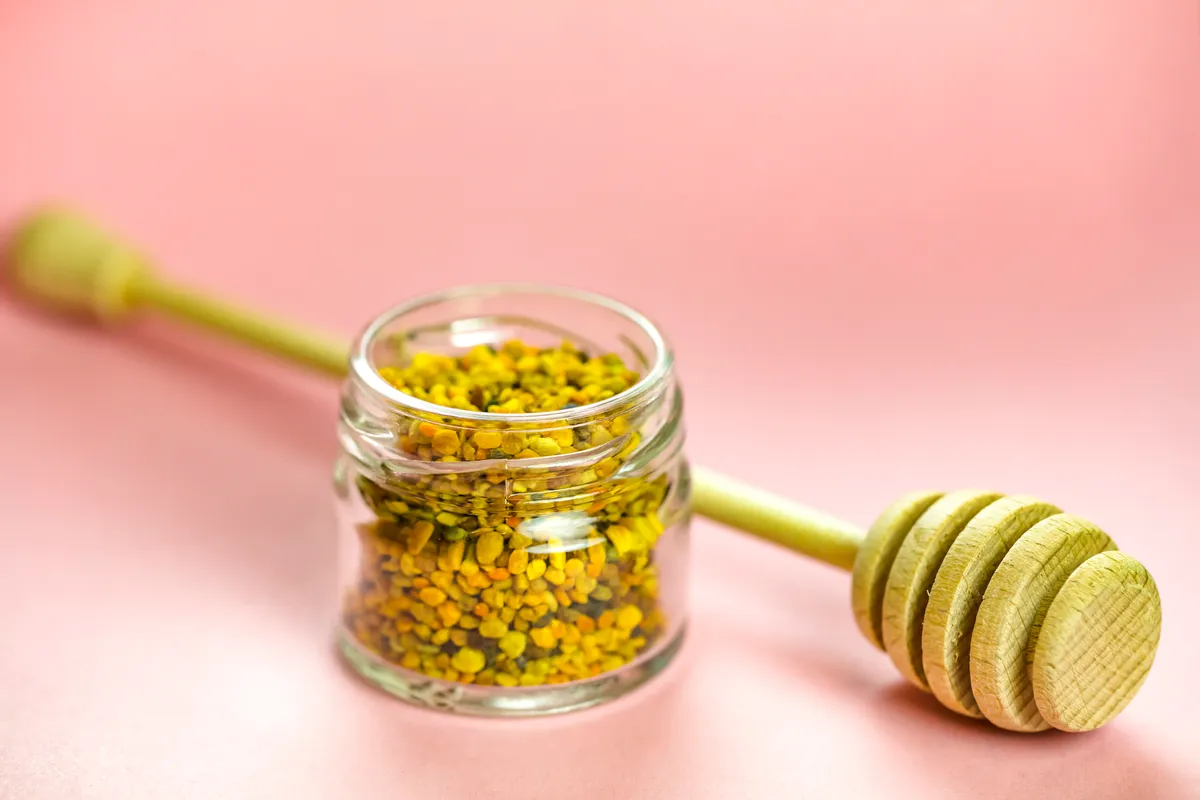
Bee pollen is a natural mixture of flower pollen, nectar, enzymes, honey, wax and other bee secretions. Some health professionals claim that bee pollen is a superfood, full of nutrients, amino acids, vitamins and lipids, and in Germany it has been recognised as a medicine by the Federal Ministry of Health.
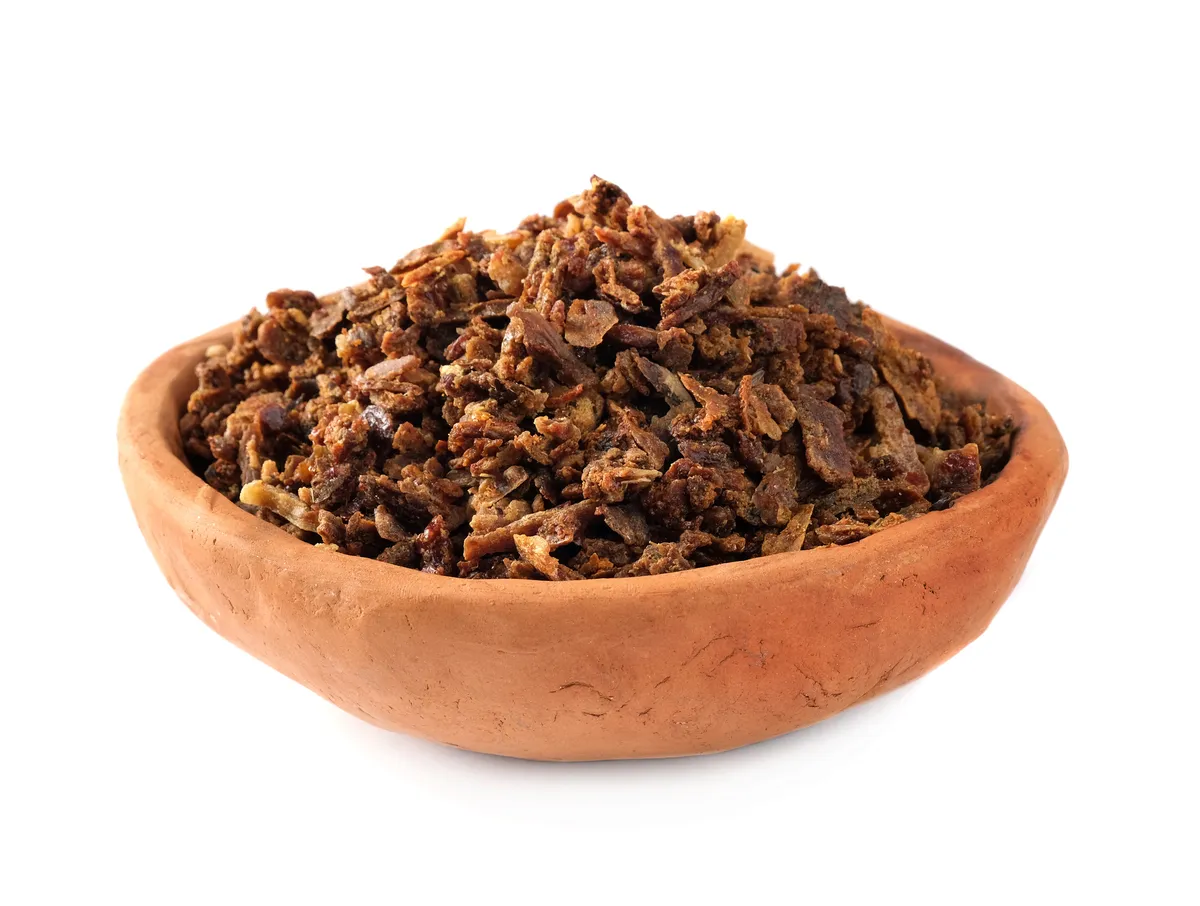
Propolis, also known as bee glue, is a resin-like mixture made from bee saliva, beeswax and a fluid from tree buds and sap called exudate. Honeybees use propolis as a sealant to close unwanted open spaces within the hive. Propolis has been used in traditional medicine for thousands of years. Its anti-inflammatory and antimicrobial properties make propolis helpful in healing wounds. It is also an effective varnish for string instruments, particularly to seal the surfaces of new violins.

Royal jelly is a hypopharynx gland secretion used to feed larvae in a colony, as well as adult queens. For the first three days of their existence, all larvae are fed royal jelly, regardless of their gender or status, but after three days, only the queen larvae continue to be fed. Royal jelly is regarded by some as a superfood, and is collected and sold as a dietary supplement. However, there is little current evidence to support most health claims.
How long have humans been keeping honeybees?
Evidence of the relationship between Homo sapiens and honeybees dates back to around 12,000 years ago, when humans were transitioning from hunter-gatherers to farmers. In the wild, bees make and store honey inside a hexagonal prismatic wax cell structure called honeycomb, which can be found built into trees. The earliest known record of humans harvesting this honey is from an 8,000-year-old cave painting in La Cueva de la Araña in Valencia, and shows someone climbing up to a nest in a tree with a basket. This wasn’t exactly beekeeping, but honey stealing.
Over time, humans learnt to ‘keep’ bees rather than tracking them for their honey. This was most likely for practical reasons, just as farming livestock was easier than hunting in the wild, but many ancient civilisations also believed that bees were sacred beings deserving of worship and protection.
In Britain, one of the most primitive forms of ‘hive’ was called an alveary, a cone-shaped willow or hazel basket, protected from the weather by a layer of daub made of manure, ashes and lime. With the arrival of the Anglo-Saxons, the alveary was replaced with the skep, a more rounded, basket- shaped hive made of similar materials.
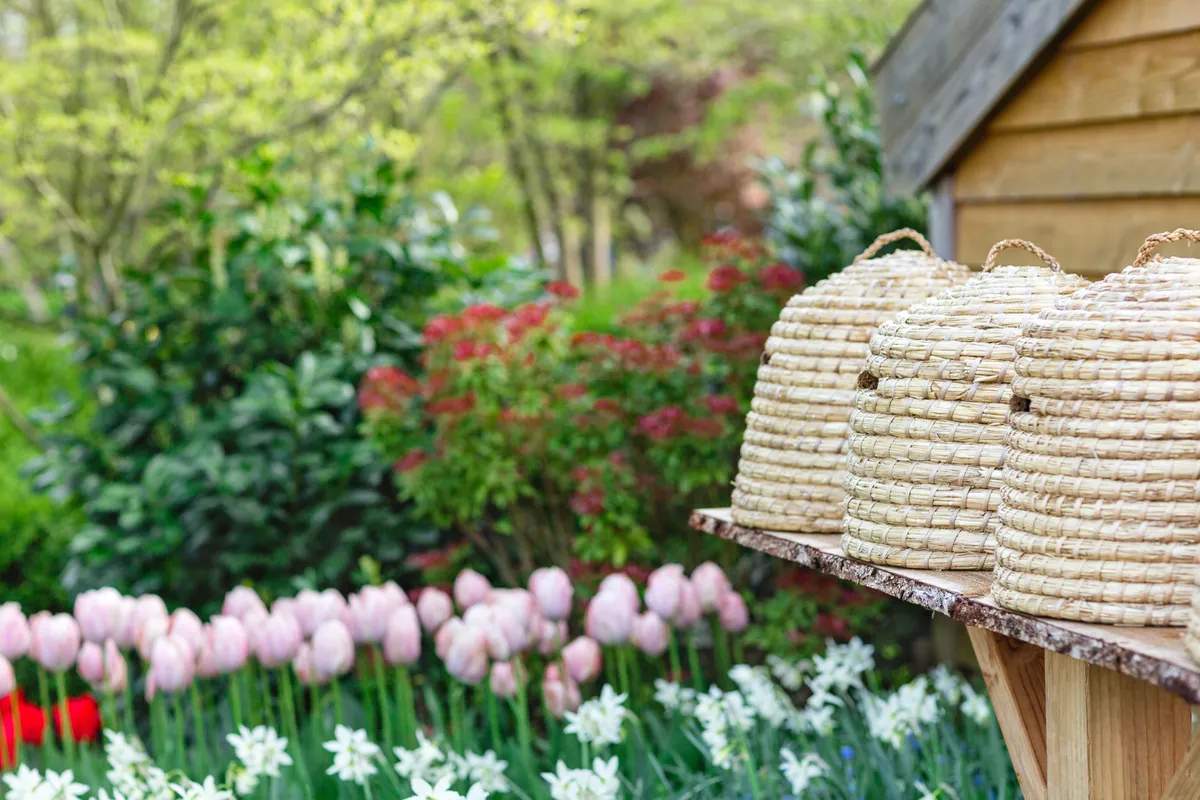
From the eighteenth century onwards, a series of ‘modern’ beehive designs began to emerge, with one of the main aims being to prevent the destruction of the colony when collecting honey. The focus of these new designs was to add sliding frames or bars into the hive, so that each frame could be removed, the honey collected, and the frame replaced without harming the bees.
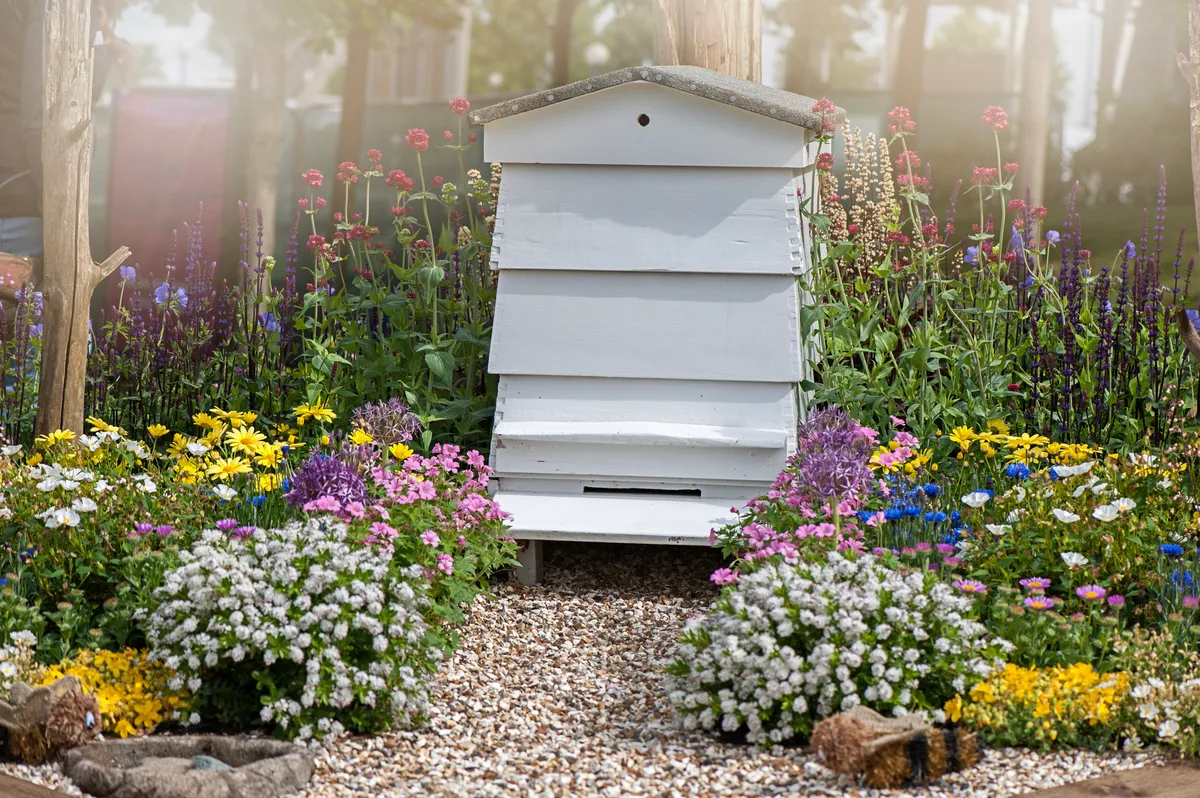
Today, three of these modern designs are still in use around the world: the Langstroth hive, the top-bar hive and the Warré hive. Their designs may vary slightly or even hybridise, but the essential structures remain the same. Of the three, the Langstroth hive is the most commonly used for commercial beekeeping.
Why do honeybees swarm? And how does a beekeeper catch a swarm?
During a swarm, thousands of honeybees leave their hive en masse and circle before settling nearby. The resulting ball of bees clustered on a branch, fence or wall is one of the most imposing spectacles of early summer. But you’re unlikely to be stung, as swarms have no young or food stores to defend.
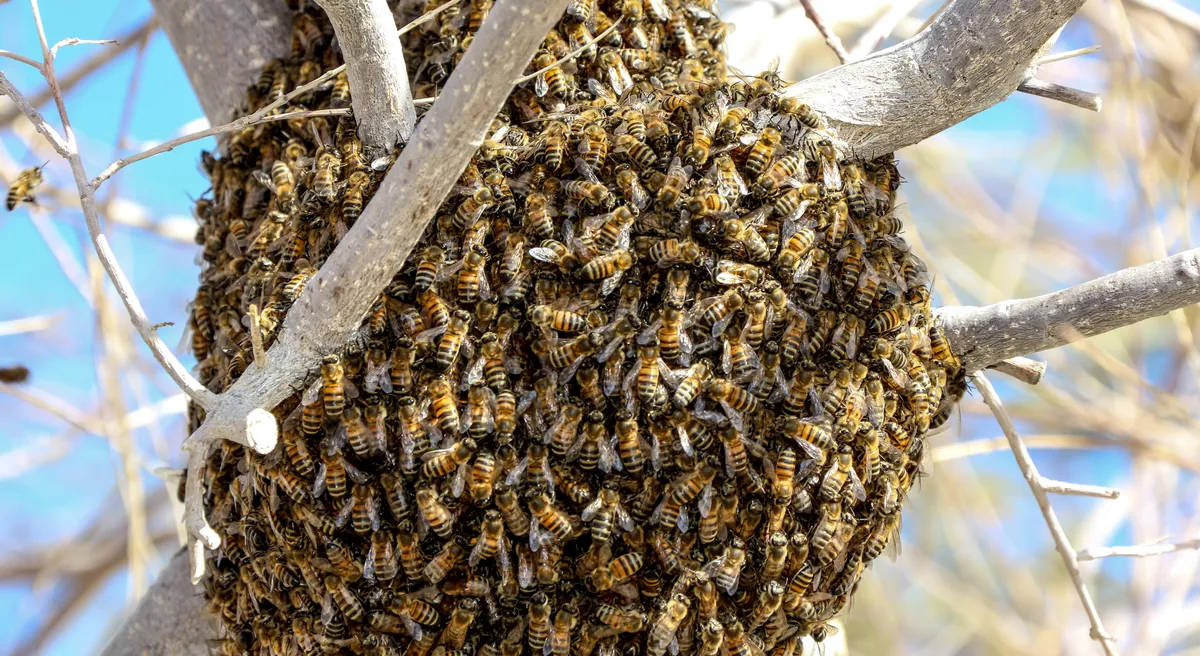
Swarming is the way honeybee colonies divide – it’s effectively a form of colony-level reproduction. The stage visible to us begins when a queen flies out of her hive or nest, taking over half of the workers with her to found a new colony, while the rest stay behind to raise replacement queens (only one of which survives).
So swarming is to be welcomed – a result of favourable weather and plentiful nectar and pollen supplies fuelling a rapid rise in numbers of worker bees. Since managing swarms can be tricky for beekeepers, a huge research effort has tried to identify the key triggers involved.
There appear to be several, including overcrowding in the ‘brood combs’ where larvae are reared, and new workers being produced too fast for the colony to feed them. Young workers are ‘house bees’ for their first three weeks, carrying out tasks within the nest, so there has to be a high enough proportion of older workers to forage for them all.
Another factor is the queen’s age. Older queens produce less of a pheromone called ‘queen substance’, which workers pass to each other by touch. If it becomes too dilute to be felt throughout a growing, crowded colony, the bees prepare to swarm.
This Q&A originally appeared in BBC Wildlife Magazine, and was answered by Ben Hoare.
Are there still wild honeybees?
In a sense, the honeybees kept in hives are wild. They come and go as they please, and are dependent on the surrounding environment for sustenance – ‘feral’ might be a better word. They are descended from a truly wild species that colonised Africa, Asia and Europe under its own steam, building its own nests in tree cavities.
Remarkably little is known about the range or abundance of these wild honeybee colonies, which is reflected in the species’ Data Deficient status on the IUCN Red List. Truly wild colonies were long suspected to be extinct in Europe, until a recent survey identified nests in Poland and Germany. The study estimated there could be up to 80,000 wild colonies across Europe.
This Q&A originally appeared in BBC Wildlife Magazine, and was answered by Stuart Blackman.
What threats do honeybees face?
One of the main threats facing honeybees today is the spread of diseases and mites from around the world, which can infect, weaken and destroy entire colonies at a time. One of the most common threats is the varroa mite (Varroa destructor), a tiny chestnut- coloured parasite that feeds and lives on both adult honeybees and their larvae and pupae. The presence of the mites can cause malformation and weakening of the bees, as well as passing on different viruses.
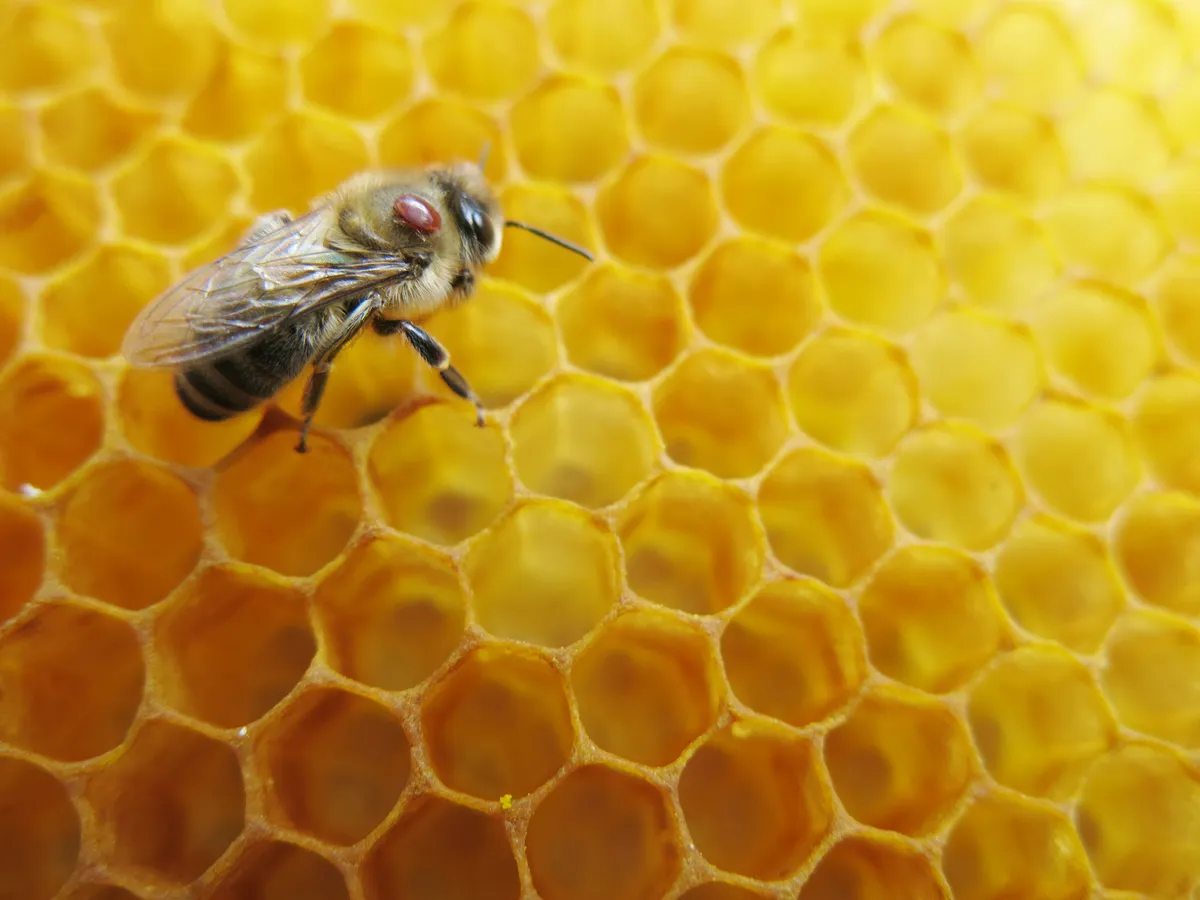
A colony with mild infestation will show very few symptoms, but once a varroa population has increased over three to four years, the hive population will decrease and the entire colony structure will break down.
Other diseases and pests threatening honeybees include colony collapse disorder, acarine mites, small hive beetle, wax moths, Tropilaelaps mites and the Asian hornet.
The Asian hornet (Vespa velutina) is an invasive non-native species from Asia which arrived in France in 2004 and has been spreading rapidly ever since. It is a highly effective predator of insects, including honeybees, and can cause significant damage to bee colonies, other species and, eventually, entire ecosystems. In the UK, all sightings of the Asian hornet must be reported to the National Bee Unit.
How can honeybees and pollinators be helped?
Pollinator decline is a complicated problem with multiple answers, but the average consumer can make everyday lifestyle changes to help bees and pollinators. Supporting organic farmers means buying produce from suppliers that avoid using any herbicides or synthetic pesticides.
At home, a wildlife-friendly garden can go a long way in helping provide food and shelter for local pollinators. Research indicates that private gardens in Britain cover an area bigger than all of the country’s nature reserves combined, estimated at over 10 million acres.
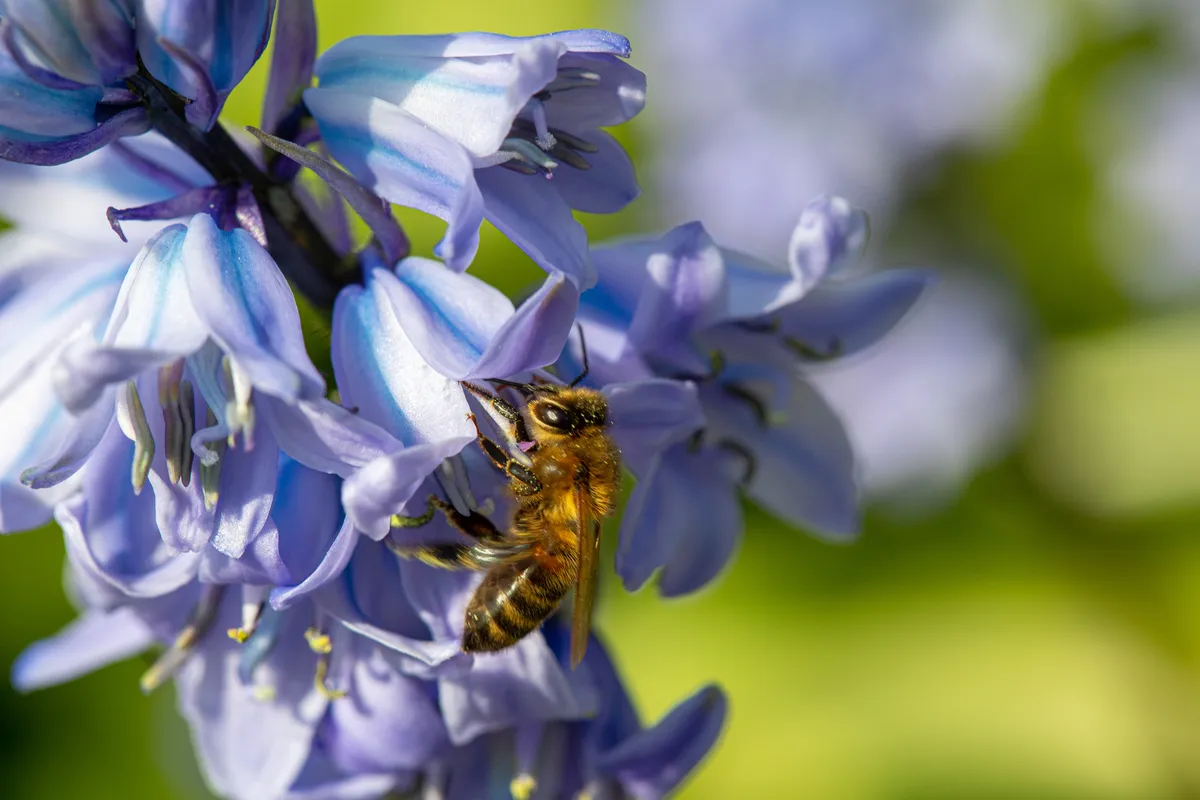
A bee-friendly garden should have plants in flower throughout the year providing bees with plenty of food, such as the bluebell, crocus, viburnum, lungwort, borage, allium, globe thistle, poppy, sweet pea, thyme, buddleia, cornflower, foxglove, honeysuckle, lavender and nasturtium. Gardeners should avoid pesticides and other harmful chemicals when maintaining the garden, and should try to provide a source of water from which all garden wildlife can benefit, such as a small pond.
This article is adapted from extracts from Bees and Beekeeping by Tiffany Francis-Baker, published by Shire Publications.
Buy now from:
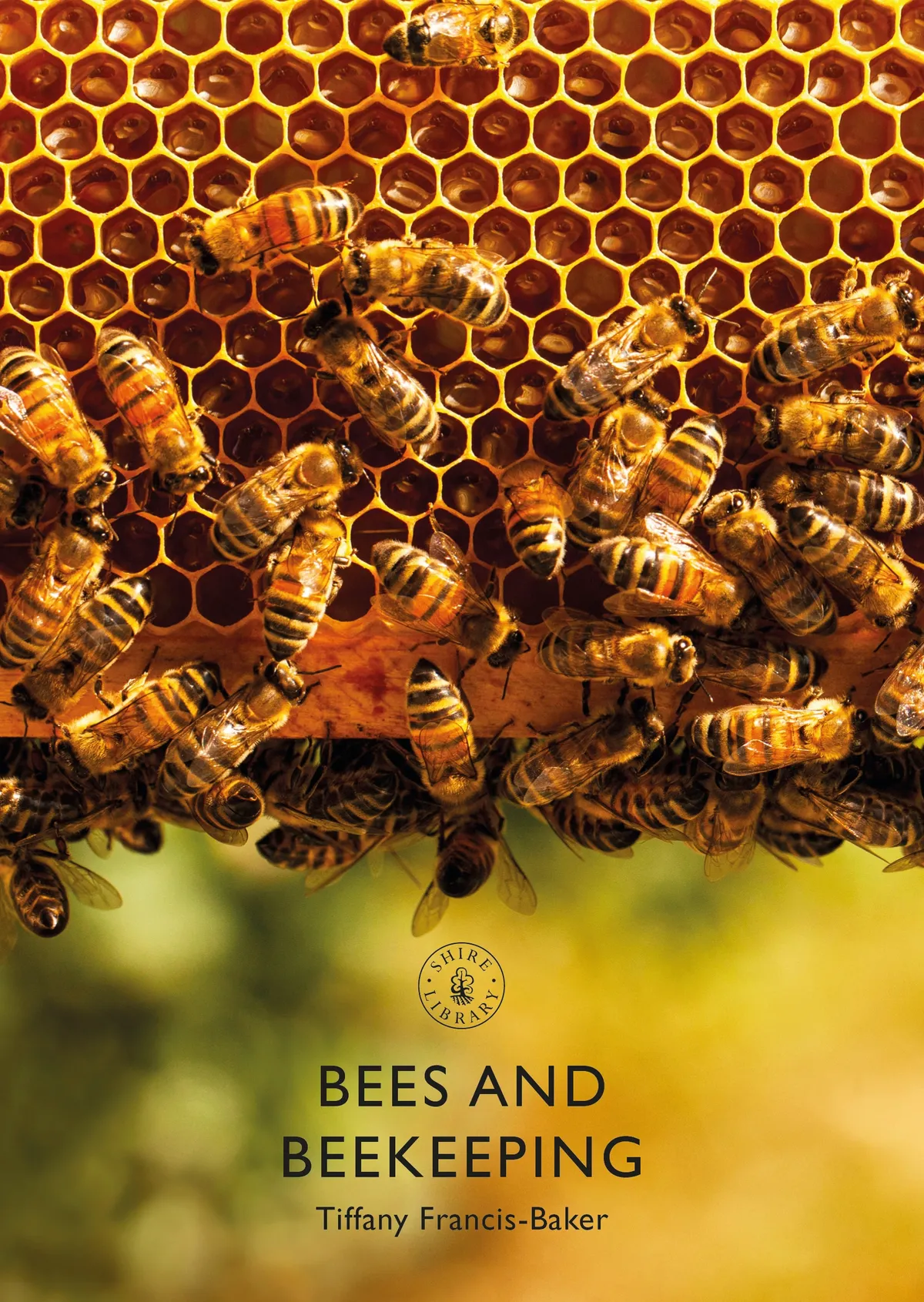
Tiffany Francis-Baker is a nature writer and illustrator from the South Downs in Hampshire UK, and is the author of number of books including: Food You Can Forage, Bees and Beekeeping, and Dark Skies.

Main image: Honeybee on a flower. © Samuel Moore/Getty
